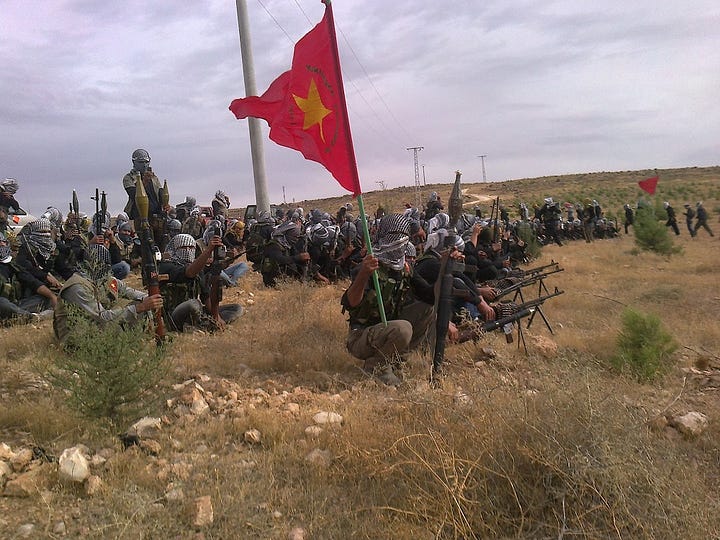Weekend notes
How the YPG/SDF ended up in control of eastern Syria, a visualization
Below is a timeline of YPG and SDF territorial expansion between 2012 - 2024, visualized through maps mostly pulled off Wikipedia with some brief explanation. It’s a bit gratuitous in terms of how many maps you can put in one post, but hopefully will be a useful reminder/explainer for why and how the SDF borders look like they do today.
The idea for this post came about as I’ve been sorting through content to add to my resource drive, available to all paid subscribers. Other material uploaded this week includes a spreadsheet of the new Syrian army divisions and their commanders, as well as a library of various decrees, appointments, and other documents issued by the Presidency and military this year. Do considering upgrading to a paid subscription to receive full access to the weekly newsletter and the resource drive.
Initial foothold
In July 2012 the regime vacated much of eastern Syria, withdrawing to the ‘security squares’ located in the centers of major cities and various military bases. By August 2012 the People’s Defense Units (YPG) had taken control of several strips of Kurdish-majority areas along the border. Meanwhile an array of local and nationally-affiliated opposition factions began popping up and taking control of other parts of eastern Syria.

February 2013: Opposition forces including Jabhat al-Nusrah and Ahrar al-Sham entered al-Hasakah from the south, first taking al-Shaddadi before capturing the towns of Tell Brak, Tell Hamis, and al-Ya‘rubiyah to the northeast. Simultaneously, the YPG extended south to connect Kurdish-populated neighborhoods of al-Hasakah city and the mostly Kurdish villages of the ‘Amude and al-Dirbasiyah countryside with its border stronghold.

To the west the YPG expanded out from Kobani to take its majority Kurdish hinterlands.

The cities of al-Qamishli and al-Hasakah remained split between the YPG and regime forces.


July 2013: After a year of small scale clashes and a tense ceasefires, serious fighting breaks out between the YPG and opposition around the town of Ras al-‘Ain/Serê Kaniyê in northwestern al-Hasakah. The YPG successfully captures the town, though soon after the opposition kicks the YPG out of Tell Abyad, the northern al-Raqqah border town located to the west. At this point the conflict in the northeast now includes the Islamic State of Iraq and al-Sham (ISIS), who entered Syria in April of that year, fighting in tandem with the opposition against the YPG and regime.

October 2013: The YPG captured al-Yar‘ubiyah from opposition forces. This was conducted in collaboration with Shammar tribesmen headed by Sheikh Humaydi Daham al-Hadi, who would soon found Quwwat al-Sanadid, the YPG’s primary Arab ally.
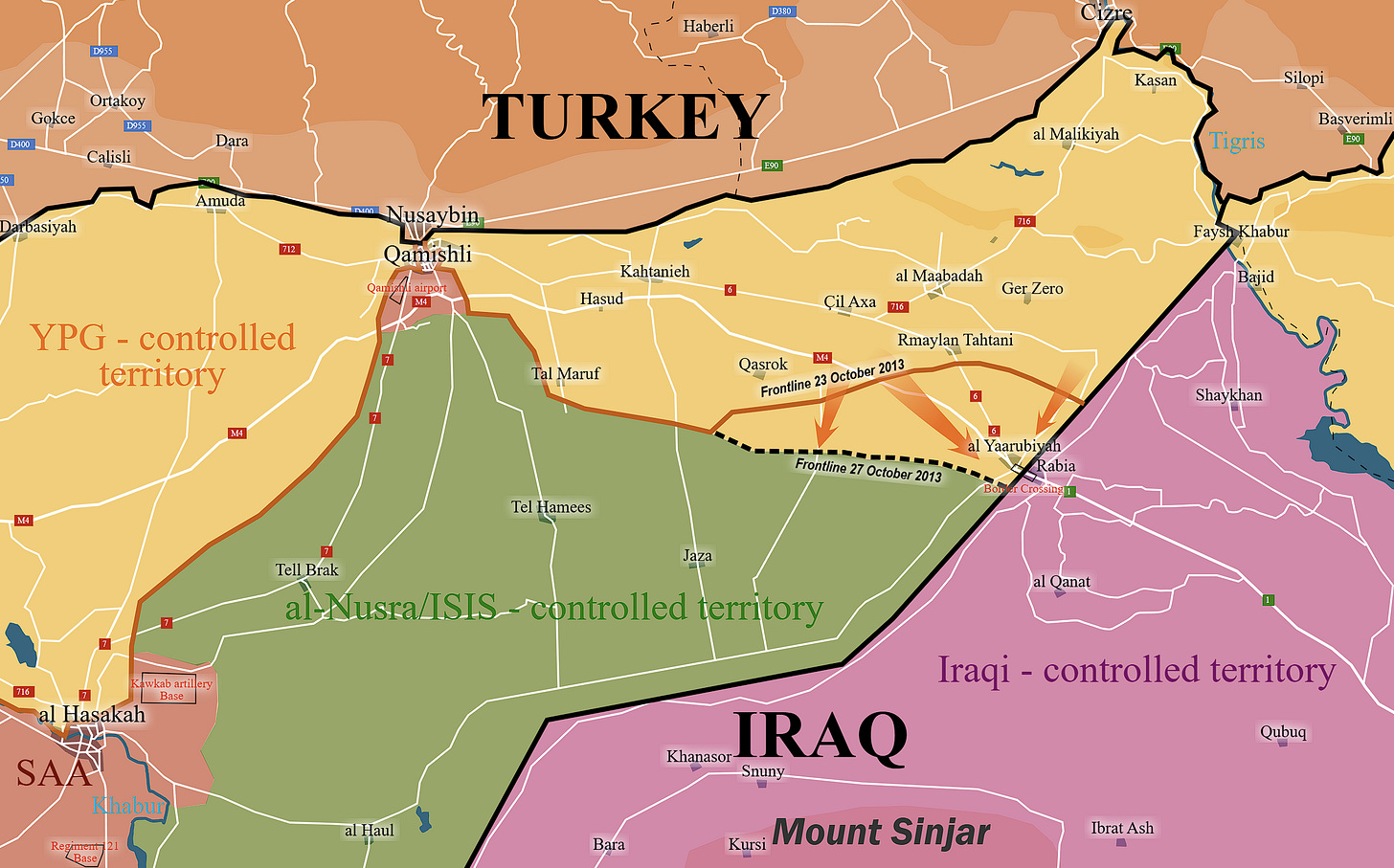
November 2013: The YPG established control over the entire upper al-Khabour river, stretching from the northeastern outskirts of al-Hasakah city to Ras al-‘Ain.
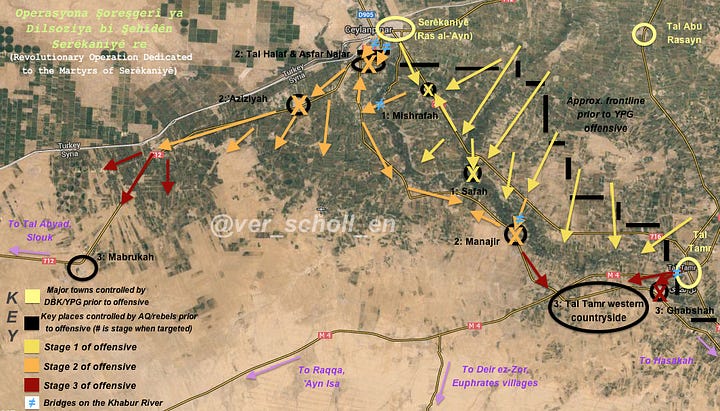
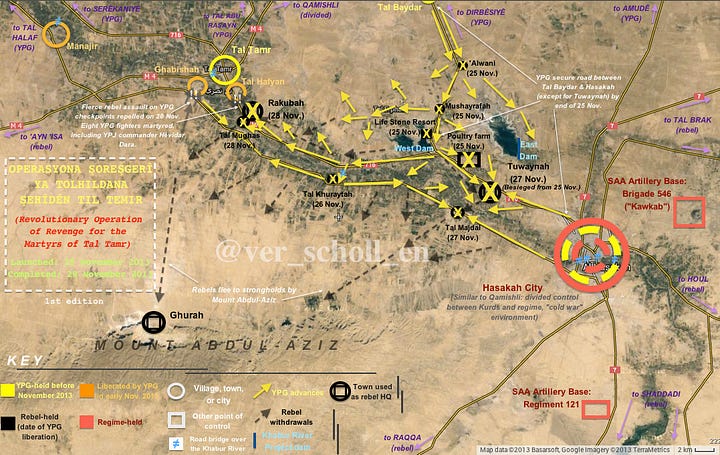
December 2013: The YPG and allies attempted to capture Tell Brak, Tell Hamis, and Jaz‘ah from the opposition, though lost most of the gained ground to a counter-offensive soon after.

Rise of the Islamic State (of Iraq and al-Sham)
Roughly eight months after entering Syria, nominally to fight the regime (and the ‘atheist Kurds’), relations between ISIS and the diverse array of opposition factions broke down into open conflict beginning in January 2014. All out war between the two sides didn’t fully take shape until the spring, as some jihadi factions tried to avoid violently engaging the group and, on some fronts like in northeastern al-Hasakah, local collaboration continued [meaning don’t take the map below too literally].

February 2014: The YPG retook Jaz‘ah and Tell Brak, though lost the latter again to an Islamic State offensive four months later.
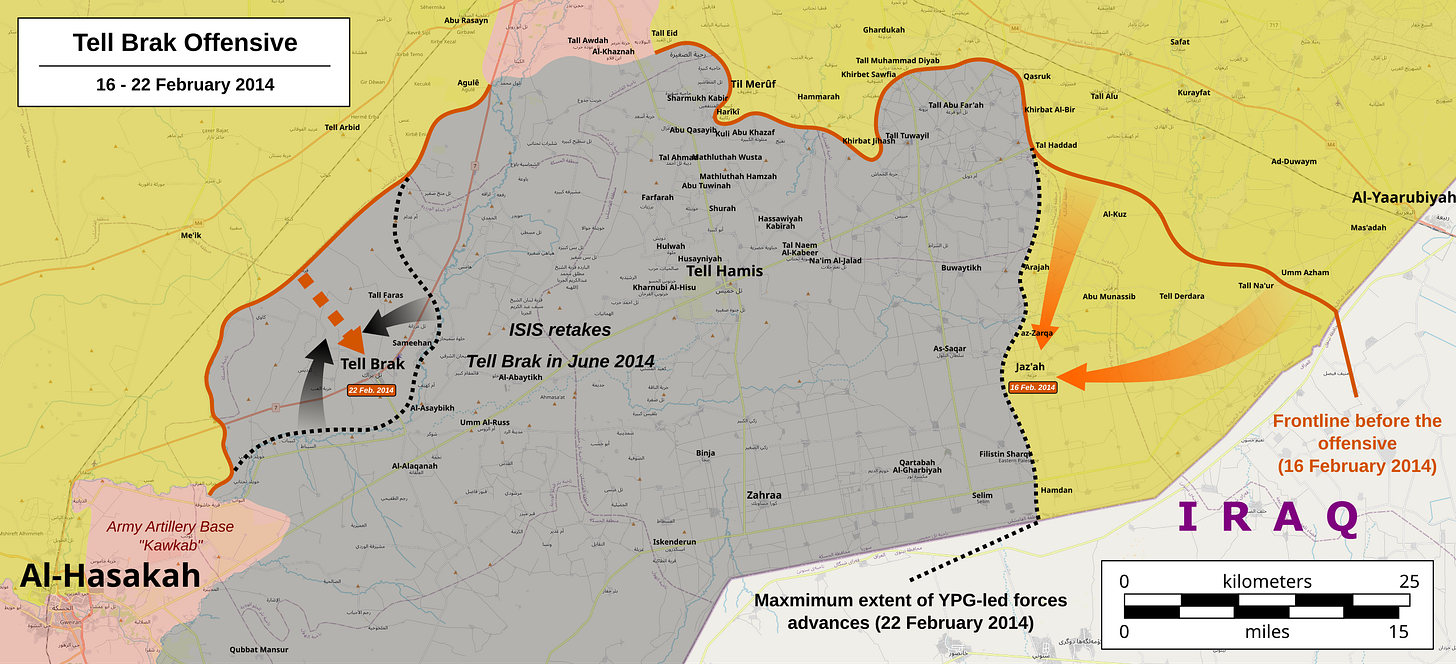
April 2014: After a brief tactical retreat from the province and a victory over Jabhat al-Nusrah in southern al-Hasakah the month prior, ISIS launched a large scale campaign against opposition in Deir ez-Zour. By July ISIS had fully captured all opposition territory in eastern Syria, declaring its caliphate soon after and changing its name simply to the Islamic Stat (IS).
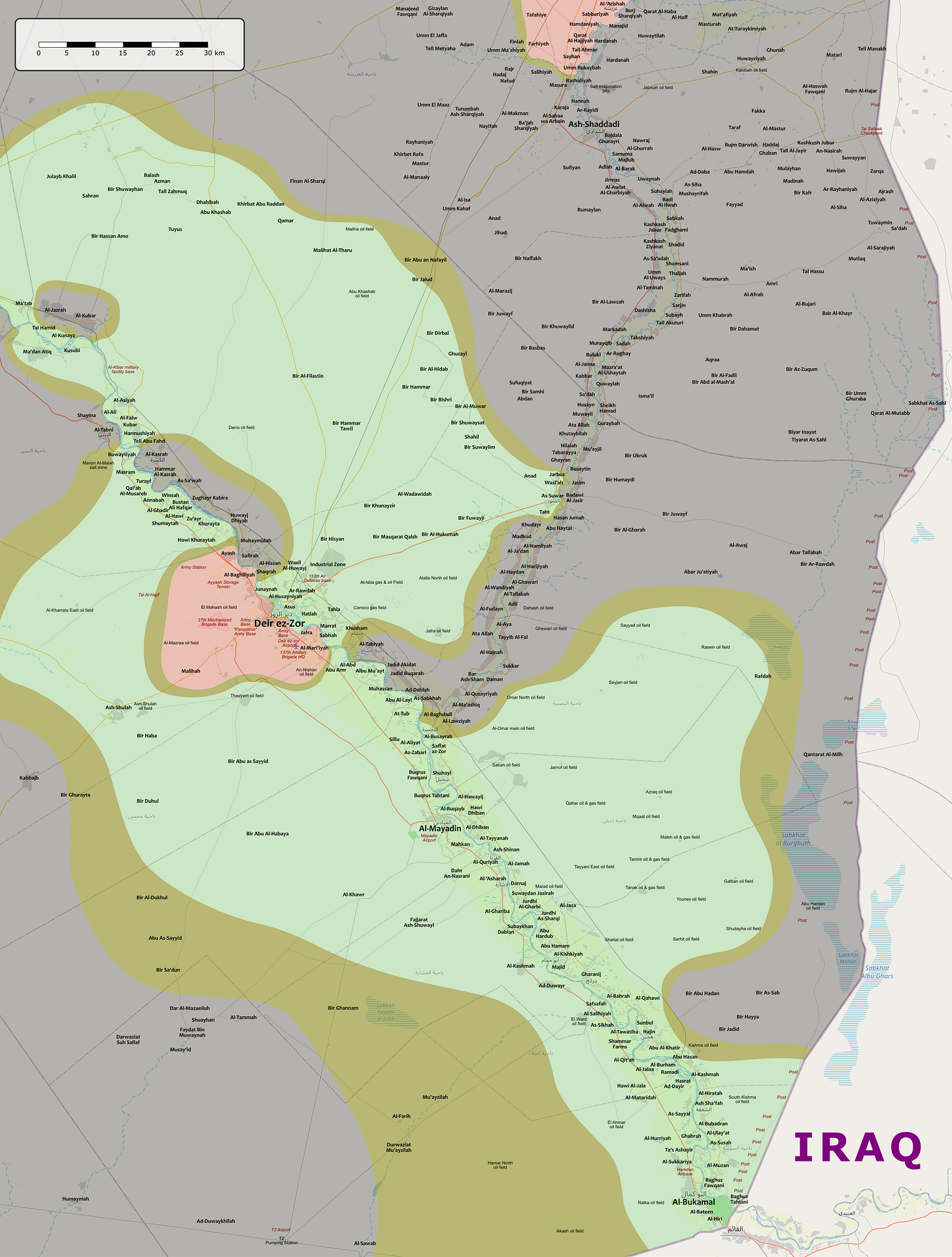
At this time some opposition and regime-controlled pockets still remained in al-Raqqah, though these were soon either defeated or forced to flee by IS.

US enters the war
The US formerly intervened in Syria on September 22nd, 2014. This occurred in tandem with an Islamic State offensive targeting the Kobani. Despite US airstrikes IS rapidly advanced, soon shrinking YPG from the entire countryside to city neighborhoods.
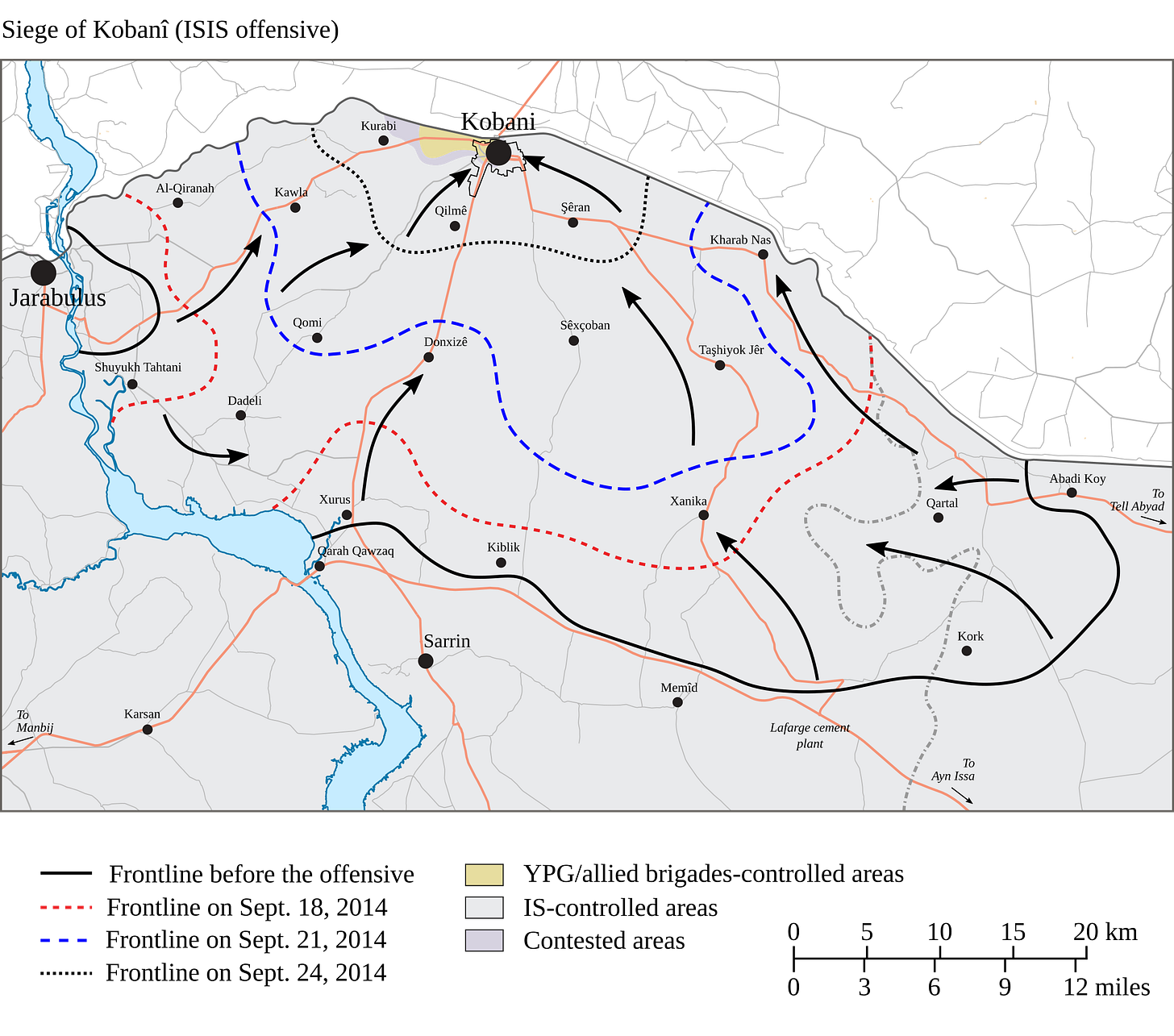
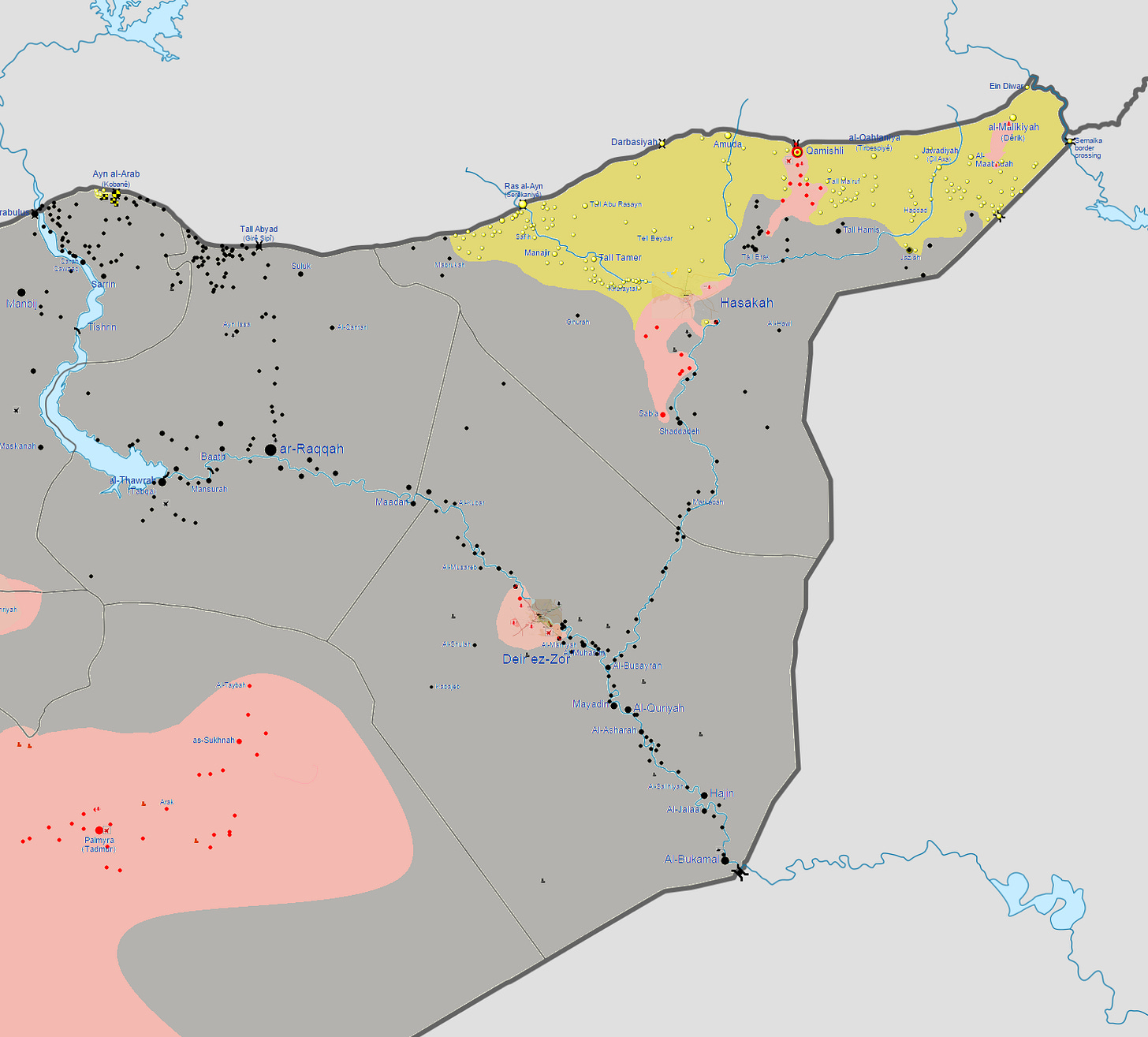
January 2015: With increased coordination between the US and YPG, as well as the limited opening up of the border by Turkey, the Islamic State offensive in Kobani was defeated and followed by a rapid YPG advance south.
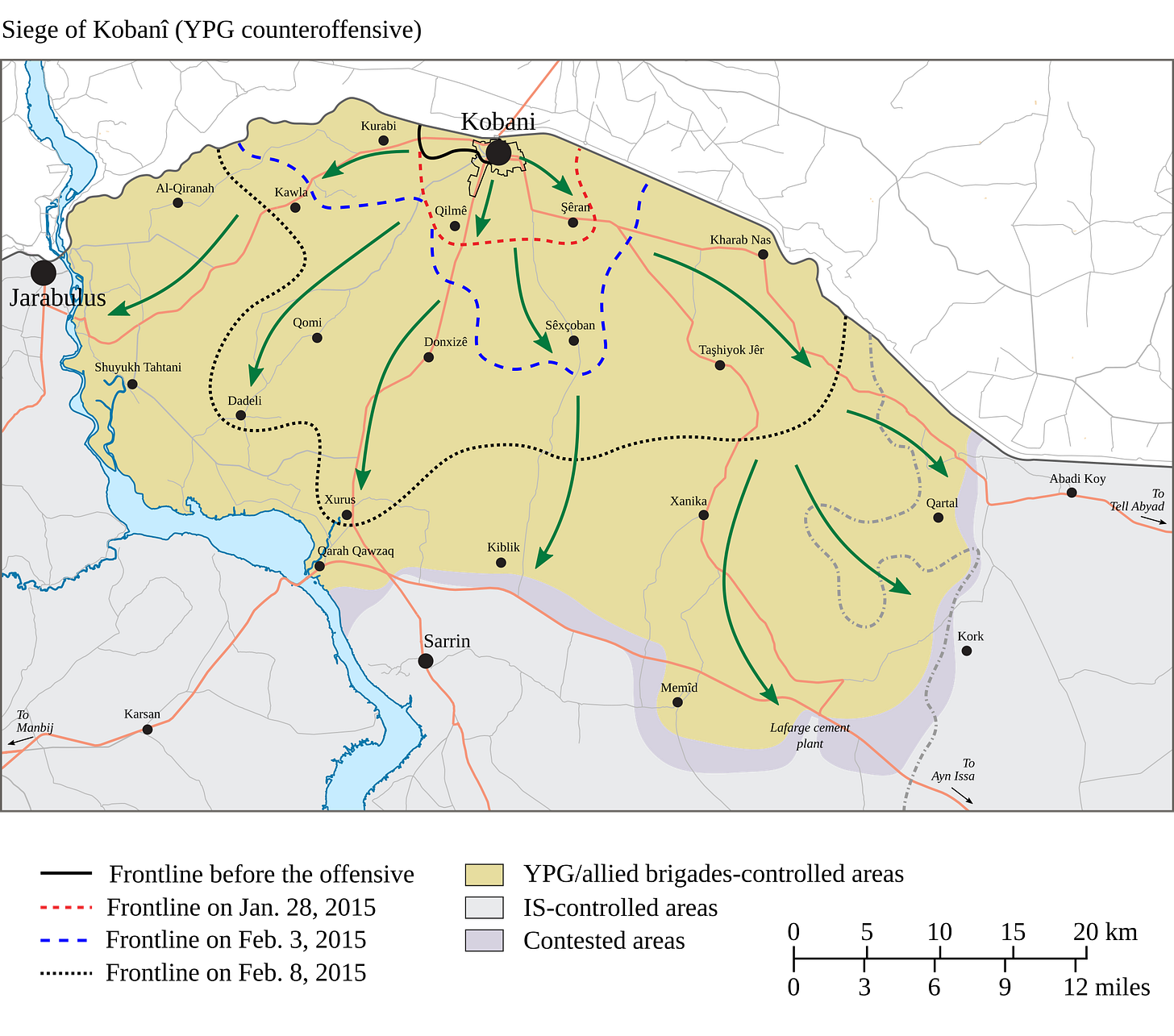
February 2015: After over a year of failing to capture and hold the towns of Tell Hamis and Tell Brak, the YPG and allies finally succeeded. This in turn fully connected the territories under its control in al-Hasakah, formerly separated by the regime-controlled neighborhoods of al-Qamishli and the villages to the south.
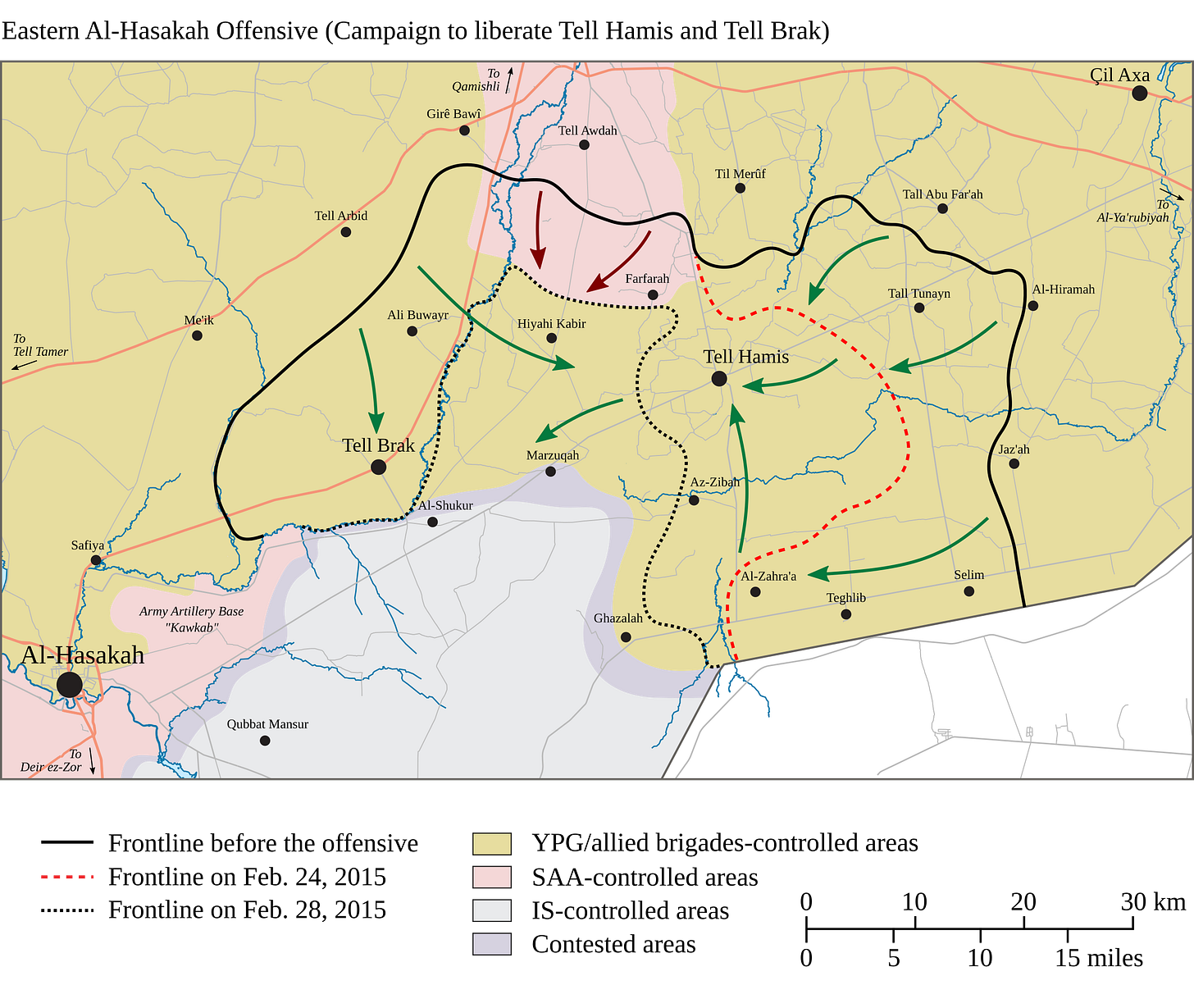
February 2015: IS launched an intense assault targeting the Assyrian villages of the upper Khabour river. This offensive was defeated and reversed by the YPG and allies three months later.
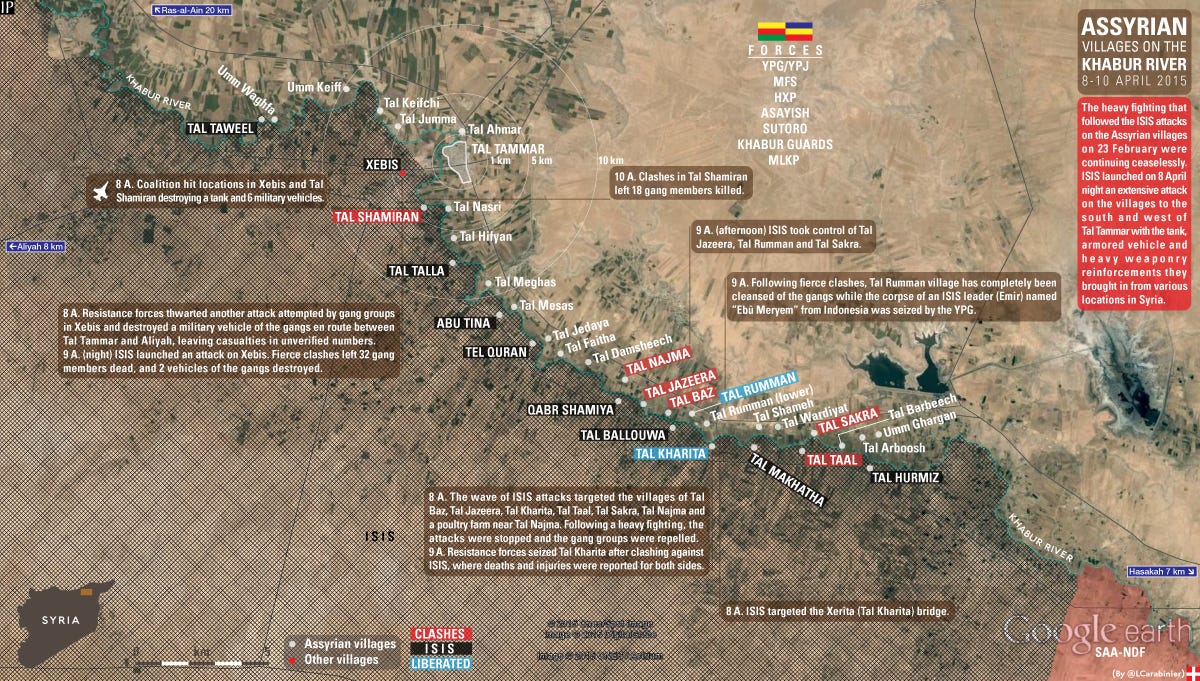
May 2015: The YPG launched a two prong offensive from the east and the west, targeting the Tell Abyad in northern al-Raqqah. The town was captured in July, separating IS from the Turkish border eastern of the Euphrates.

June 2015: After a failed attempt in the spring, the YPG launched a second offensive targeting the town of Sarrin in eastern Aleppo.

July 2015: In response to an IS attack on al-Hasakah launched the month prior, the YPG successfully carried out a counteroffensive resulting in its capture of the city’s southern countryside.
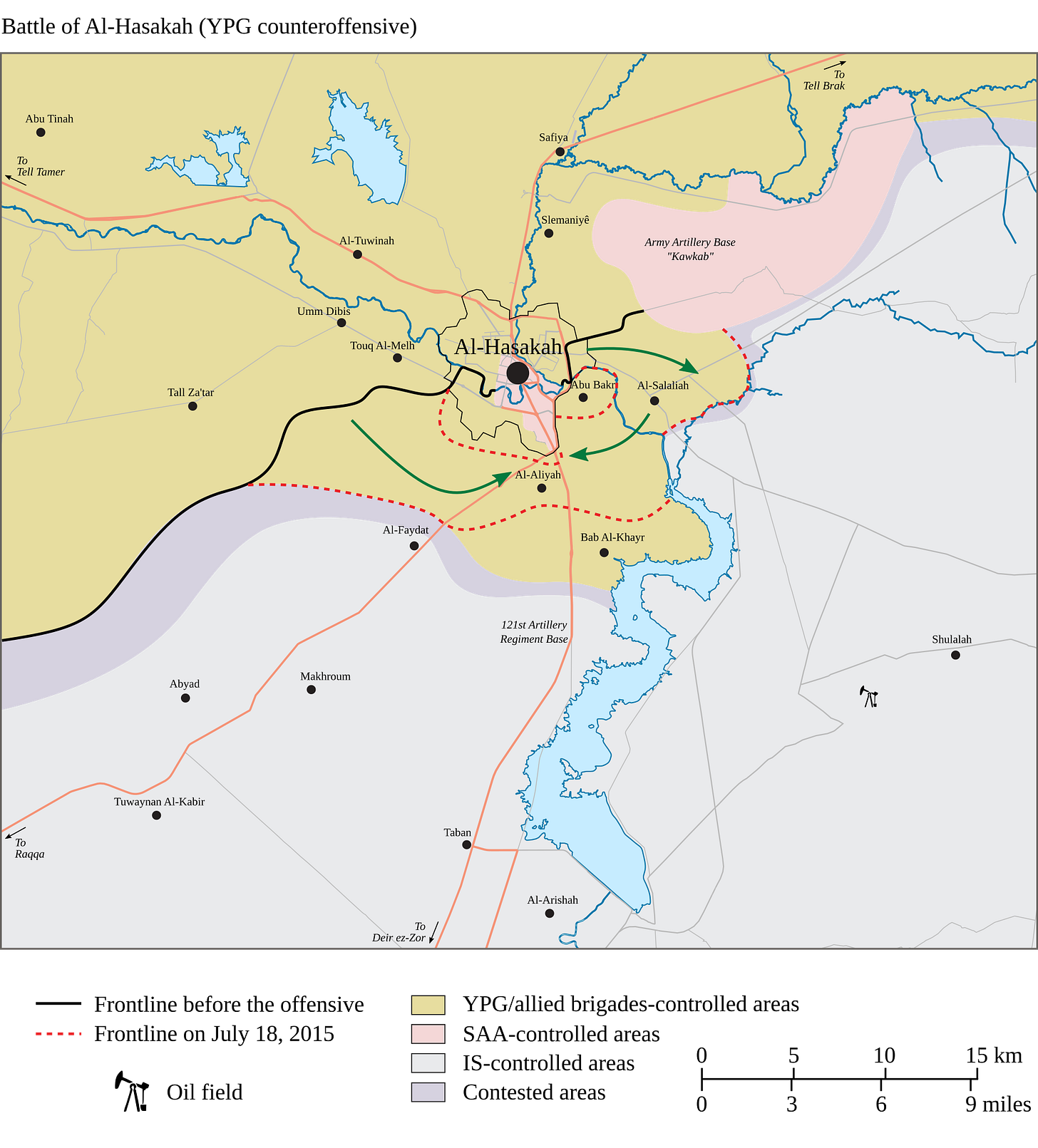
Advances under the SDF banner
In October 2015 the YPG and a number of smaller allied entities formed the Syrian Democratic Forces (SDF). The first offensive carried out under this new name targeted al-Houl and Iraqi border region east of al-Hasakah city. This was soon followed by another offensive capturing al-Shaddadi to the south.

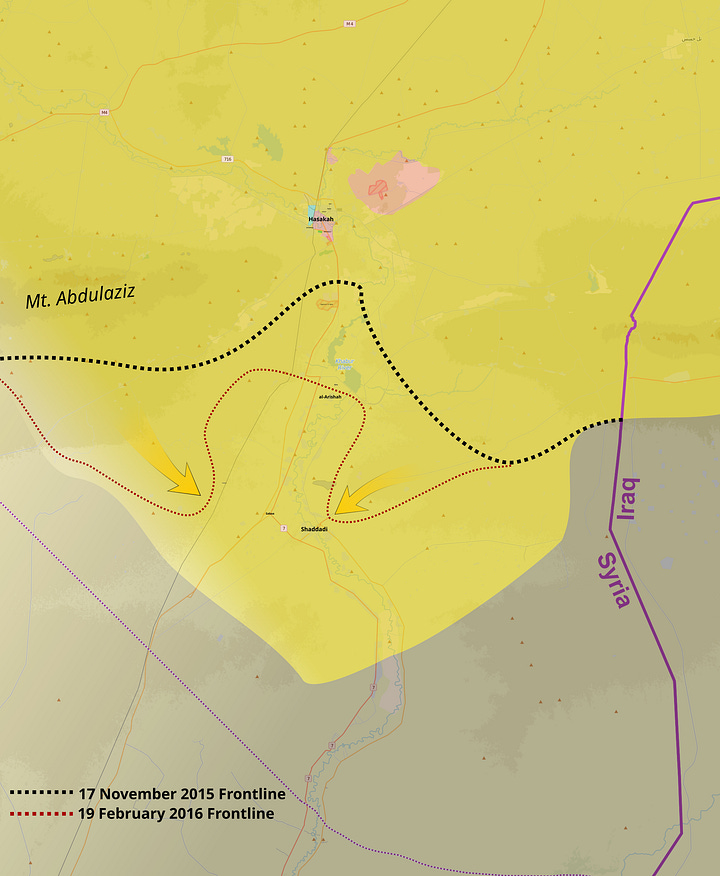
December 2015: Despite Turkish protestations, the US-led Coalition assisted the SDF in capturing the Tishrin dam and crossing the Euphrates river into the Manbij district.
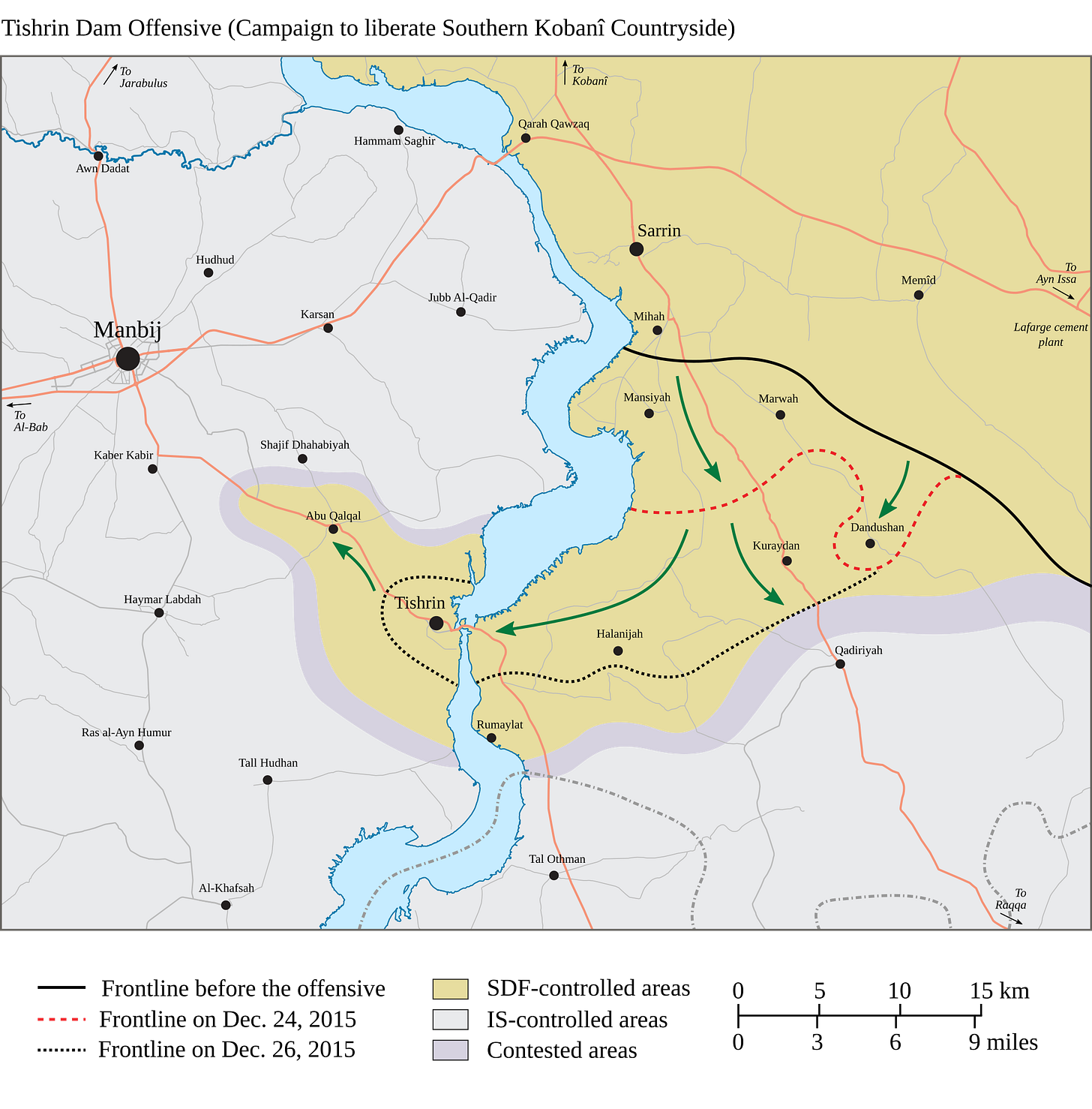
June 2016: After a several month pause in operations west of the Euphrates, the Manbij offensive (“Operation Martyr and Commander Faysal Abu Layla”) began, leading to the encirclement of the city in early June and its capture two months later. Under two weeks later Turkey launched Operation Euphrates Shield, its northern Aleppo offensive. Clashes between the SDF and the Turkish military and its proxies soon occurred in the vicinity of the Sajour river, north of Manbij, which became the demarcation line between the two sides.

August 2016: As had occurred several before before and was to occur several times after, clashes between the Asayish and the regime’s National Defense Forces (NDF) broke out in al-Hasakah city. After a week of fighting, the Asayish and SDF was able to significantly shrink the regime-controlled pocket at the center of the city (though slightly overstated in the map below).
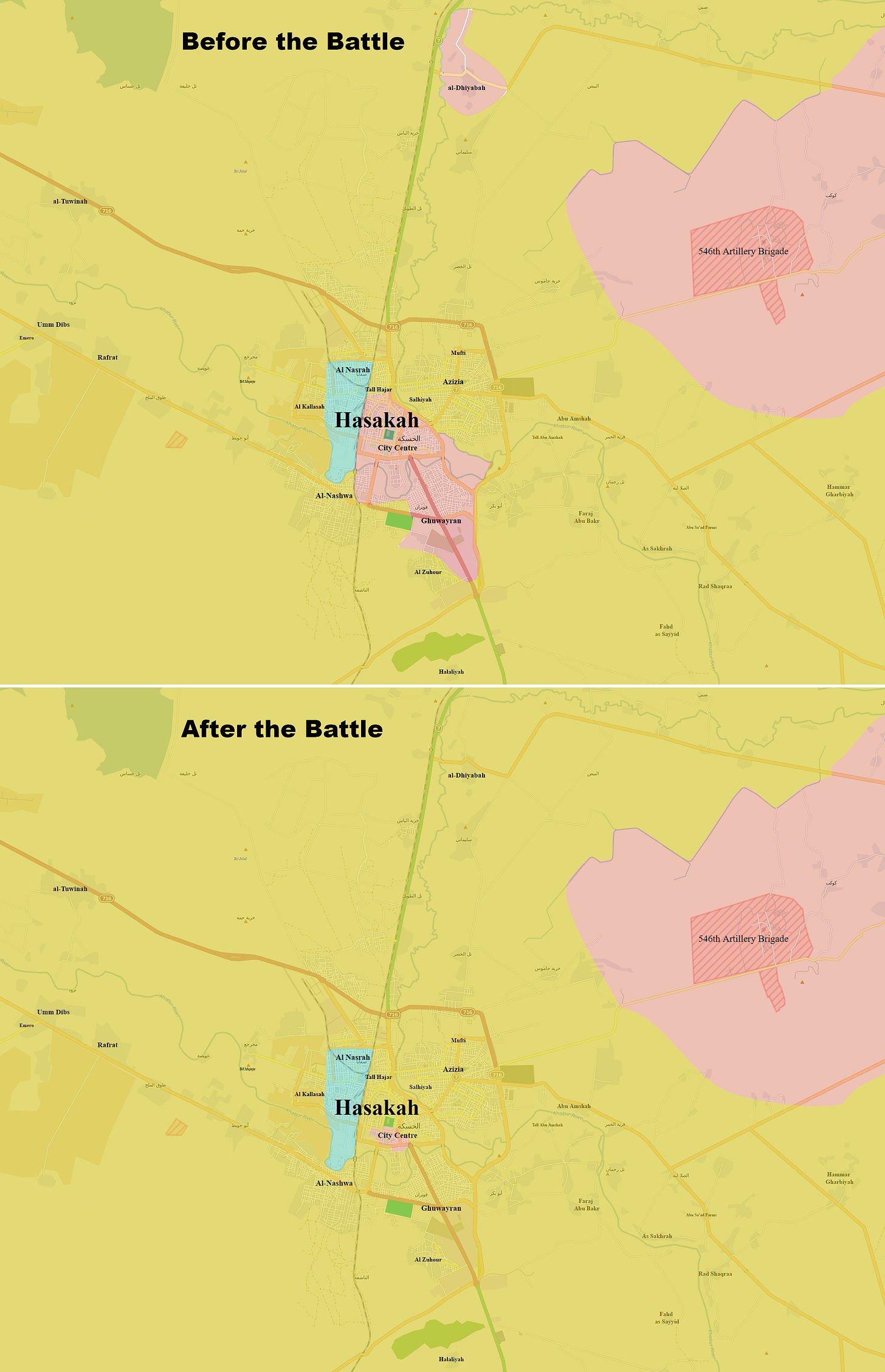
By the end of 2016, the SDF controlled a solid band of territory stretching from Manbij through northern al-Raqqah to Iraqi border, encompassing almost all of al-Hasakah governorate apart from three regime-controlled enclaves (al-Qamishli security square and the southern countryside, Jabal Kawkab/546th Artillery Brigade base, and the al-Hasakah countryside) and a small stretch of Islamic State-controlled territory to the southeast.
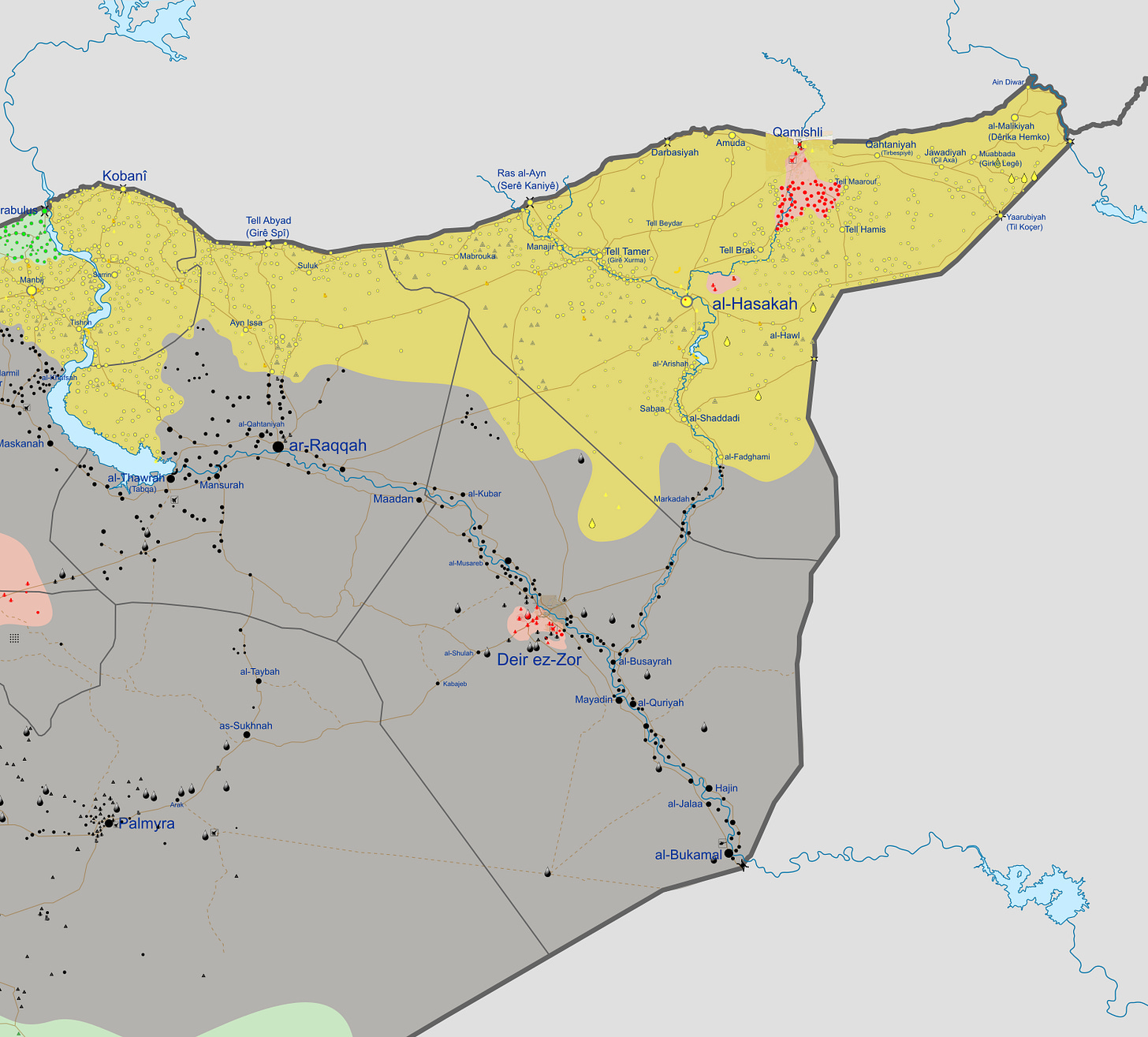
November 2016: The SDF formally announced the beginning of its al-Raqqah campaign (“Operation Wrath of Euphrates”) in the fall of 2016 though did not begin encroaching on the city itself until February the following year. The battle for al-Raqqah city began in June 2017 and lasted about four months, with the SDF fully capturing it by October 20th.

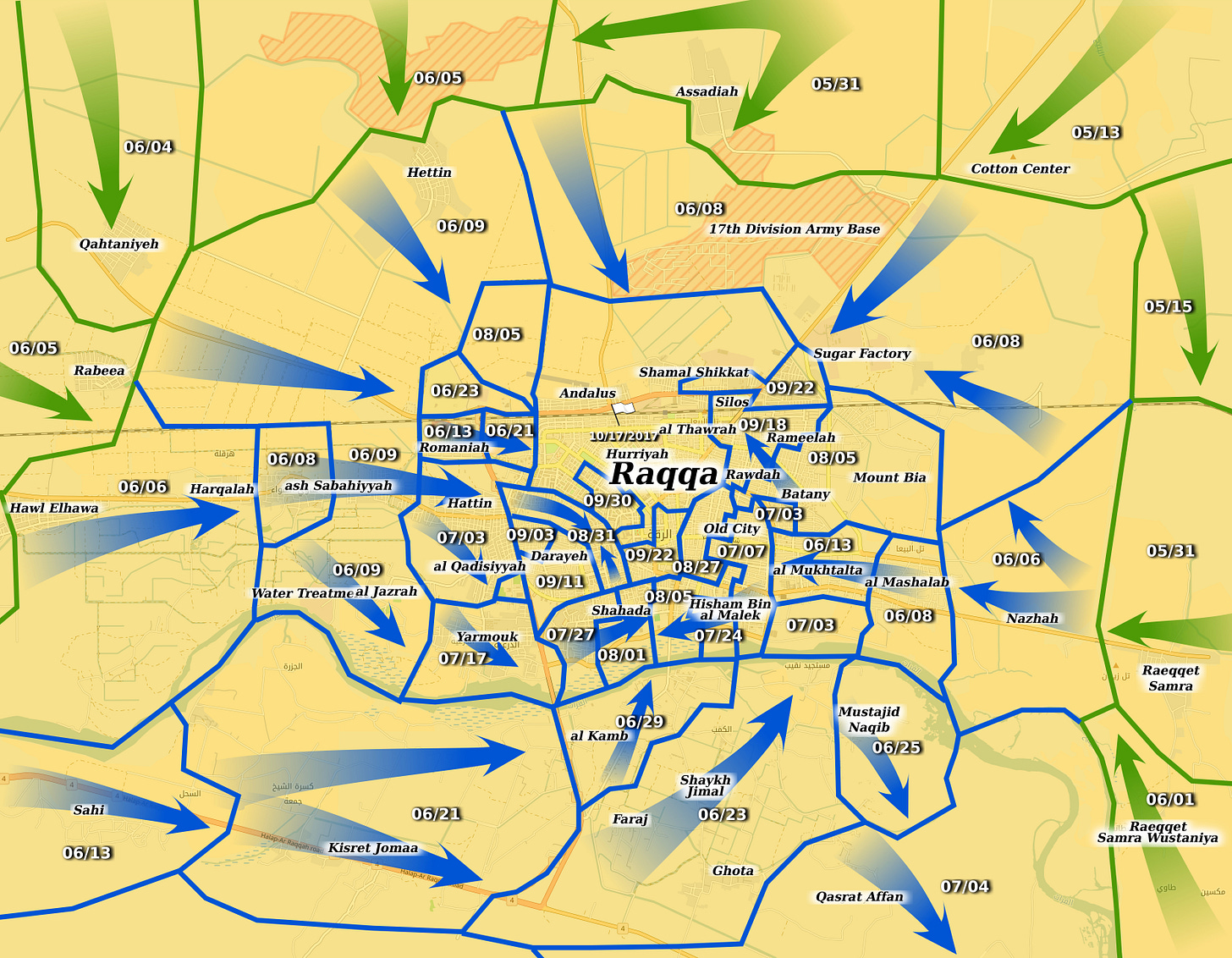
September 2017: The SDF’s final offensive against IS (“Operation al-Jazeera Storm”), took place over a year and a half and was carried out in three phases. It culminated in the March 2019 capture of al-Baghouz, the last town in Deir ez-Zour before the Iraqi border. During this time the regime carried out a simultaneous offensive against IS on the other side of the river. In the first month of the operation regime forces crossed the Euphrates and captured what has become known as the ‘seven villages,’ the only part of left bank Deir ez-Zour that remained outside SDF control until December 2024 (pic 4 below). This was also the site of the ‘Battle of Khasham’ in February 2018 that featured Wagner mercenaries on one side and the US military on the other.
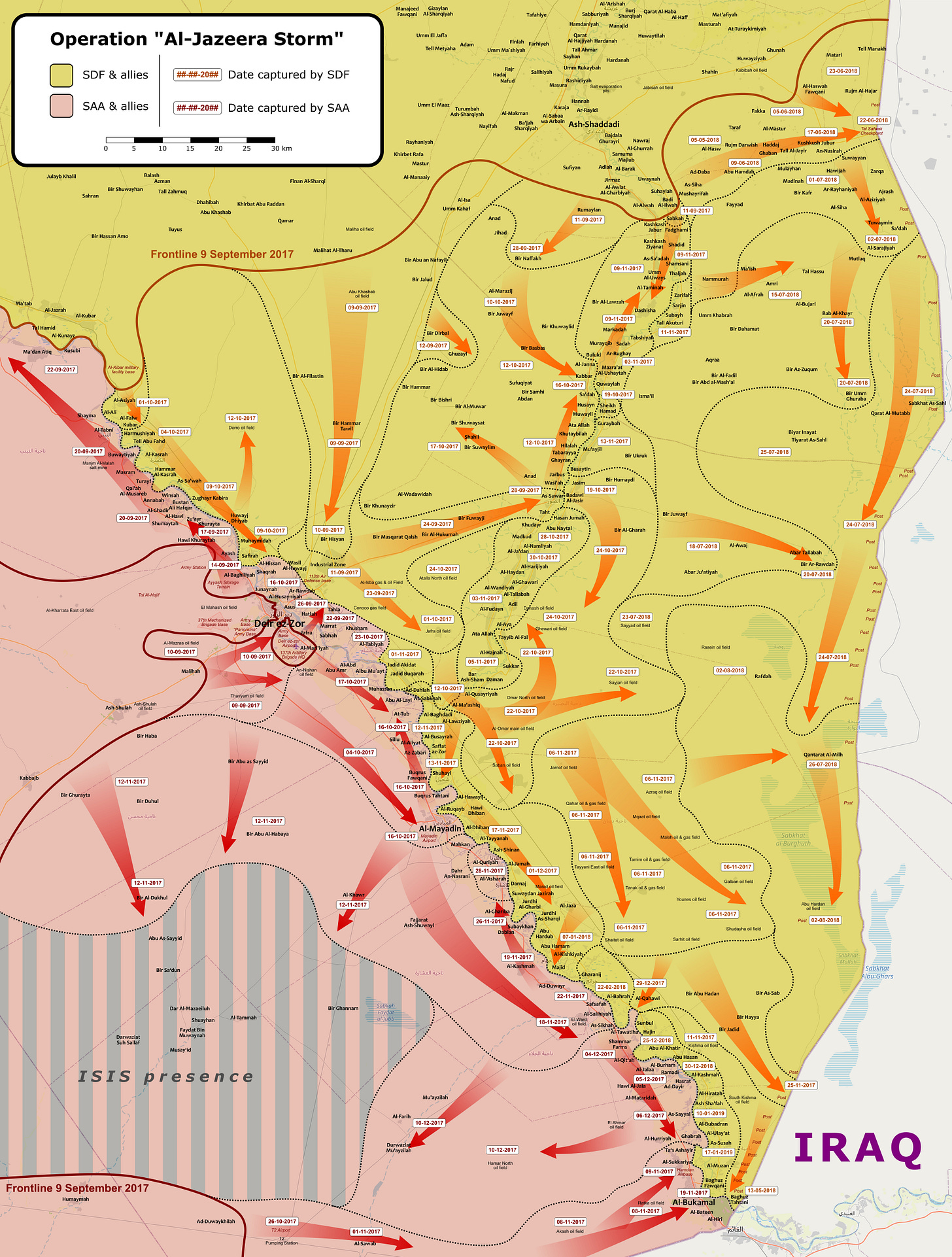
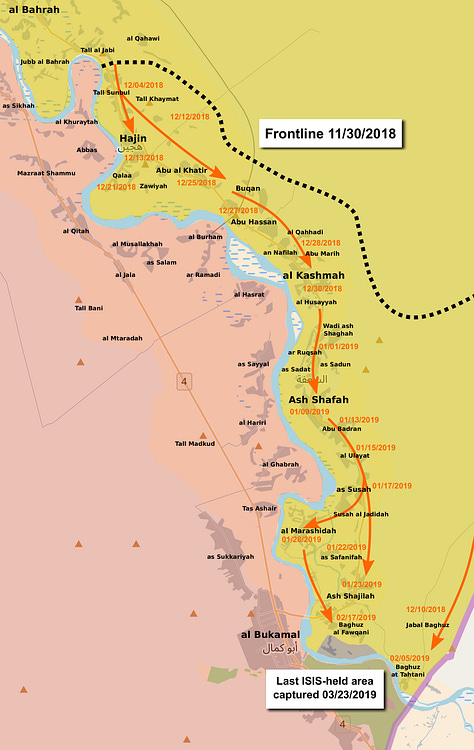


Formation of the late stage lines
October 2019: Turkey and the SNA launched Operation Peace Spring, a cross-border invasion of SDF-controlled northeastern Syria. This resulted in the capture of both Tell Abyad and Ras al-‘Ain, prior to the freezing of the front lines by way of agreements reached between Russia and Turkey, and the US and Turkey.
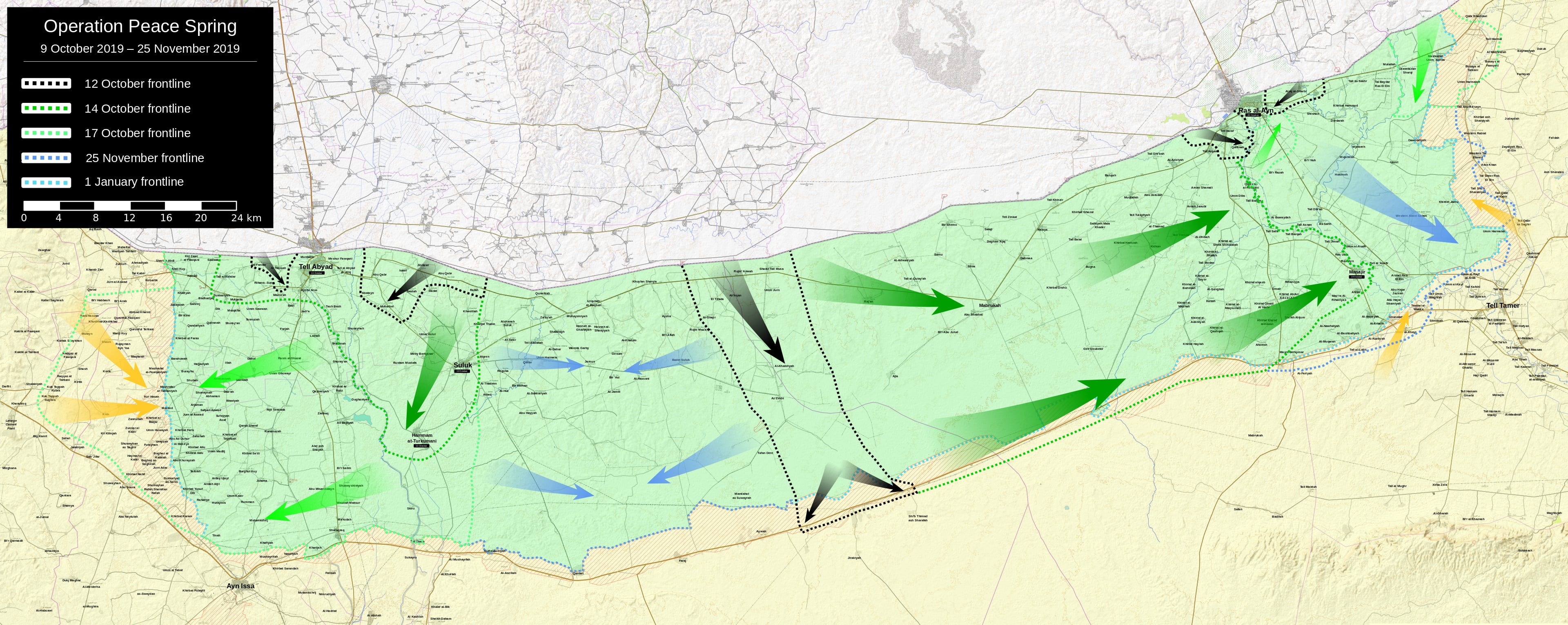
April 2021: Six days of clashes broke out between the Asayish and NDF inside al-Qamishli city, resulting in the former capturing the southern Tayy nieghborhood and the latter agreeing to vacated the city all together (with local Syrian Arab Army units remaining).

From then on, the front lines between the various actors present in eastern Syria remained static until the HTS offensive of November 2024.
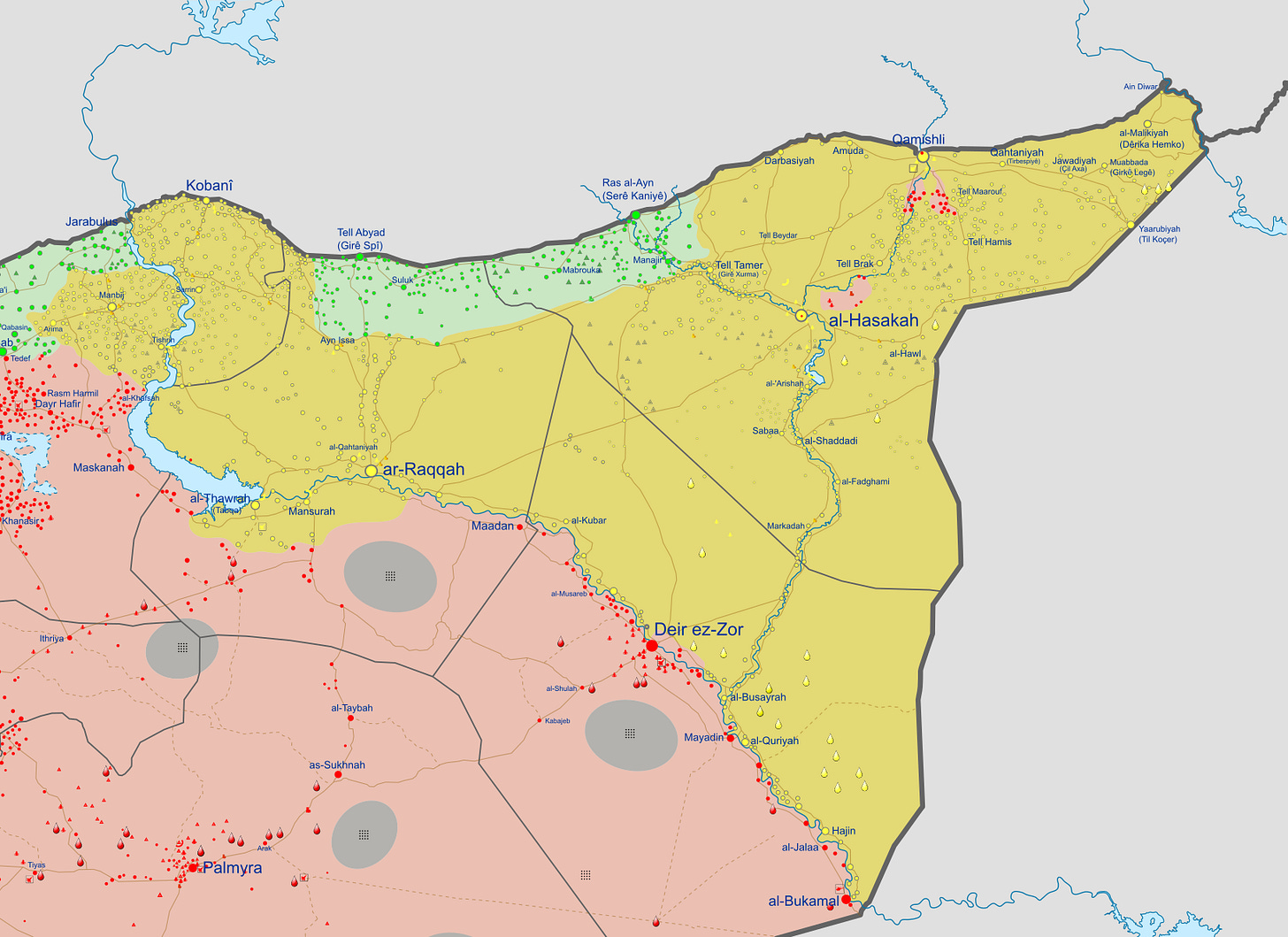
With the evaporation of the regime in the early days of December, the regime pockets of al-Hasakah disappeared and the SDF quickly advanced along several fronts. These included in Deir ez-Zour where the SDF took the ‘seven villages’ and crossed the river entering the city itself for a couple days before withdrawing and leaving it the government forces. In al-Raqqah the SDF advanced east down the right bank, seizing several towns but stopping before Ma‘dan just west of the Deir ez-Zour border. Meanwhile in the Raqqah desert it reportedly gave up some temporarily captured locales in the vicinity of al-Rusafah.

The most dramatic turn of events post-November 2024 occurred in Eastern Aleppo, where the SNA captured Manbij from the SDF, pushing the front line to the Tishrin dam and the Euphrates. To the south the SDF rapidly deployed forces northwest from al-Tabqah, taking the sizable towns of Maskanah and Deir Hafir before further advance was stopped by the arrival of pro-government forces in early December. The lines of contact between the two sides have remained frozen over the course of 2025.
